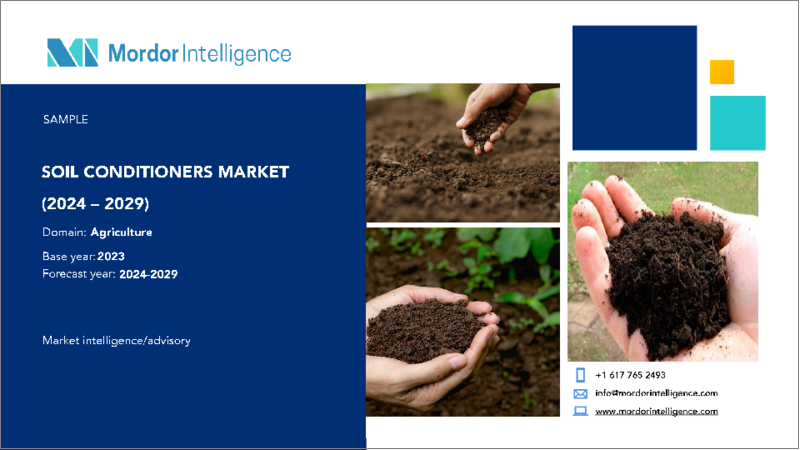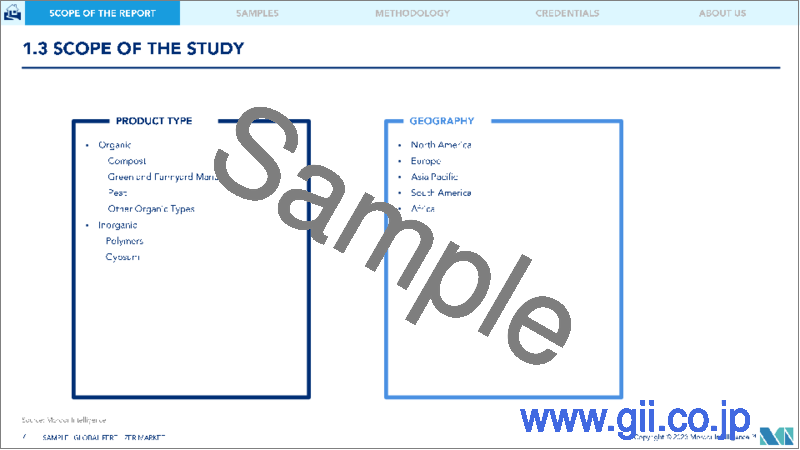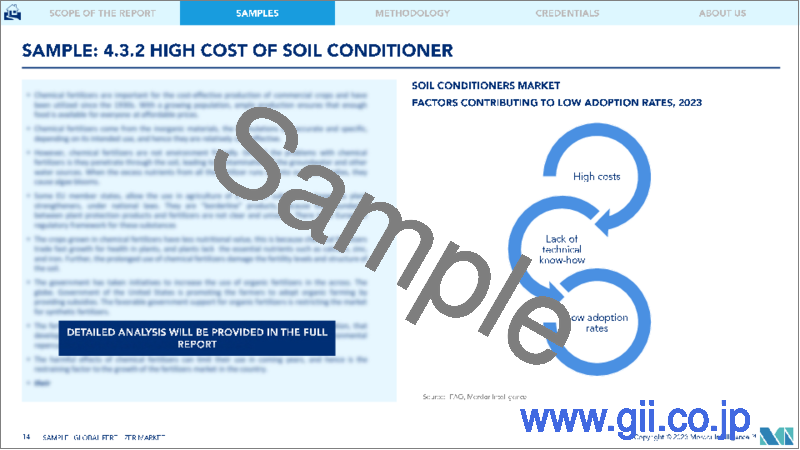|
|
市場調査レポート
商品コード
1273472
土壌改良剤市場- 成長、動向、予測(2023年-2028年)Soil Conditioners Market - Growth, Trends, and Forecasts (2023 - 2028) |
||||||
|
● お客様のご希望に応じて、既存データの加工や未掲載情報(例:国別セグメント)の追加などの対応が可能です。 詳細はお問い合わせください。 |
|||||||
| 土壌改良剤市場- 成長、動向、予測(2023年-2028年) |
|
出版日: 2023年04月14日
発行: Mordor Intelligence
ページ情報: 英文 90 Pages
納期: 2~3営業日
|
- 全表示
- 概要
- 目次
土壌改良剤の世界市場は予測期間中に5.8%のCAGRで推移すると予測されます。
主なハイライト
- 肥料の大量使用により、土壌の劣化が世界の問題となっており、有機物や土壌肥沃度の枯渇に繋がっています。一方、都市化や工業化に伴う農業の激化は、廃棄物の発生を急激に加速させています。
- 例えば、石炭採掘による廃棄物は世界的に大量に発生し、そのほとんどが埋立地や貯水ダムに投棄されています。そのため、持続可能な食糧生産は、様々な廃棄物をより有効に活用し、土壌改良剤などの付加価値の高い製品を作るための世界の技術革新を促しています。
- 現在、土壌改良剤は、植物の成長や土壌の健康状態を改善し、化学肥料の使用量を減らすために重要な役割を担っています。例えば、フィンランド南部の農地から流出するリンは、バルト海に面したこの地域の水質や生きた海洋資源にとって最大の脅威であり、従来の農法では不十分であることが証明されています。そこで、石膏を農地の土壌改良材として使用することで、流出汚染を50%削減し、バージン鉱山のリンの需要を減少させ、産業廃棄物を再利用します。このことは、今後数年間の市場の成長を後押しすることになるでしょう。
- 土壌管理は、ますます重要な世界的課題となっています。国連食糧農業機関(FAO)によると、世界の土壌の38%が劣化しており、土壌有機物の減少、塩分、酸性、またはアルカリ性、肥沃度の低下などを引き起こしています。土壌の状態や構造の劣化、食糧安全保障の必要性、土壌の栄養管理の強化などが、今後数年間における土壌改良剤の市場成長を促進する要因となっています。
土壌改良剤の市場動向
土壌の状態および土壌構造の劣化
- 国連食糧農業機関(FAO)によると、2050年までに灌漑用地は3,200万ヘクタール拡大し、収穫された灌漑用地は17.0%拡大すると予測されています。これらのシナリオは、発展途上国で示されることが予想され、その結果、作物の養分供給が不足することになります。
- 国連の試算によると、世界全体で約19億ヘクタールの土地が生産性を失い、20億人が土地の劣化の影響を受けています。このままのペースで土地の劣化が進むと、2050年には地球の陸地の95%が劣化すると言われています。そのため、最終製品の品質低下とともに、農作物の収穫量の減少につながります。
- また、世界の人口増加により、食糧生産に使用される耕地面積の割合が減少しています。そのため、土壌の悪い場所での栽培が必要となっています。土壌の劣化は、土壌侵食の増加、過放牧、森林伐採、鉱業、工業開発などの人為的な活動により、直接的・間接的に農業生産性や水質に影響を与えています。土壌改良剤と灌漑の利用効率の向上は、土壌状態への入力側に対処するものであり、これが最近の土壌改良剤市場を牽引しています。
- 世界中の農家は、緑肥や堆肥などの土壌改良材を使用して、土壌の肥沃度を回復させ、植物が栄養分や水を効率的に取り込めるように土壌構造に対処しています。有機農業研究所(ドイツ語:Forschungsinstitut fur biologischen Landbau)(FiBL)によると、2021年に世界の有機農地は前年比7640万ヘクタール増加したといいます。市場の各社は、土壌の状態や構造を改善したいという農家の要望に応えるため、新製品を投入しています。
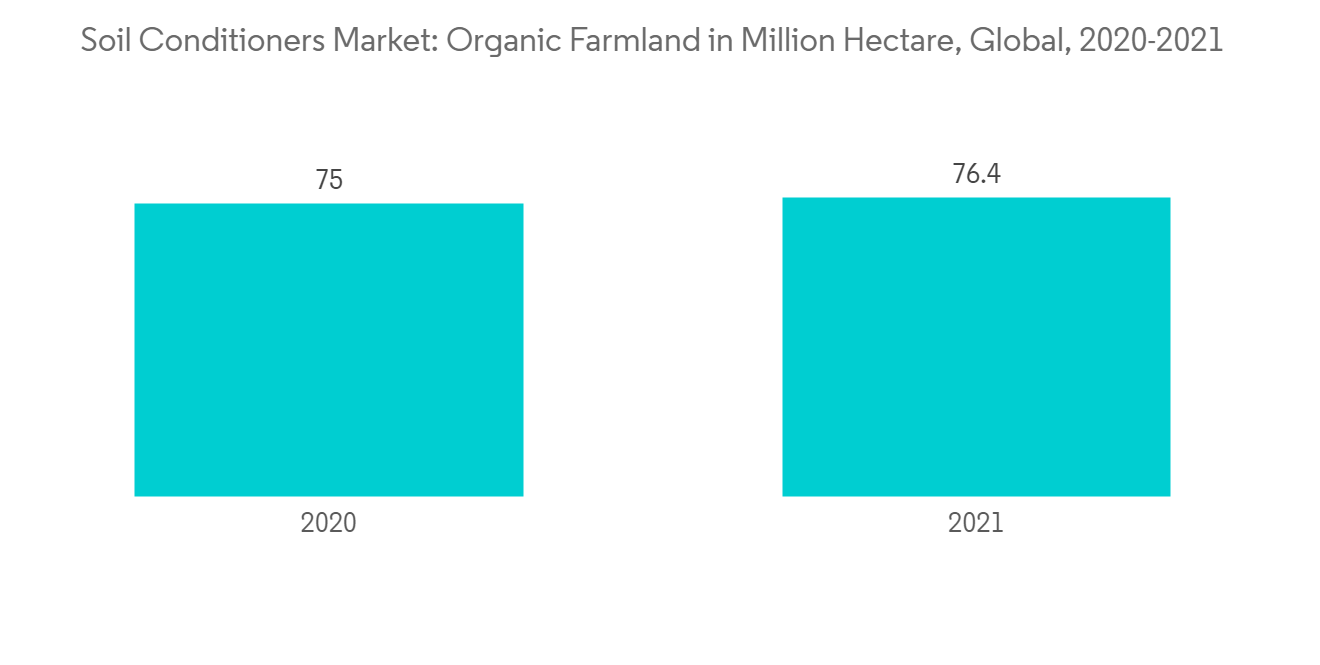
アジア太平洋地域が市場を独占する
- アジア太平洋は、広大な肥沃な土地と良好な気候条件から、農産物の最大市場の1つと考えられています。このような好条件にもかかわらず、この地域では、食糧需要を満たすために頻繁に作付けを行うため、土壌の劣化が深刻化しています。このような状況において、堆肥などの土壌改良材は、化学肥料の代替または補完として、栄養が枯渇した土壌を補う重要な役割を担っています。
- インドのような国では、農家の堆肥や緑肥などの有機肥料が、植物への栄養補給の手段として最も古く、最も広く実践されているものです。国連食糧農業機関(FAO)の報告によると、インドでは動物の飼育数が多いため、有機肥料としては農地堆肥が最も多く、同国の肥料生産量の90%を牛が占めています。
- 土壌侵食率の上昇、開墾、森林伐採などにより、農家は、増え続ける地域の人口の食糧需要に対応するため、収量と土壌の健康状態を改善する土壌改良剤に頼るようになっています。特に中国のような市場では、集約的な栽培のために化学肥料や農薬が過剰に使用され、土壌は過去数十年の間に主に劣化しています。現在、生産者は、それぞれの土壌の問題に対する効果的な解決策を求めています。主要な生産者は、農作物の生産に損失を与えることなく持続可能な地域にするために、土壌に関連する問題を解決する新しい製品ラインを革新するために研究開発に投資しています。したがって、これが将来的に土壌改良剤の市場を牽引すると予想されます。
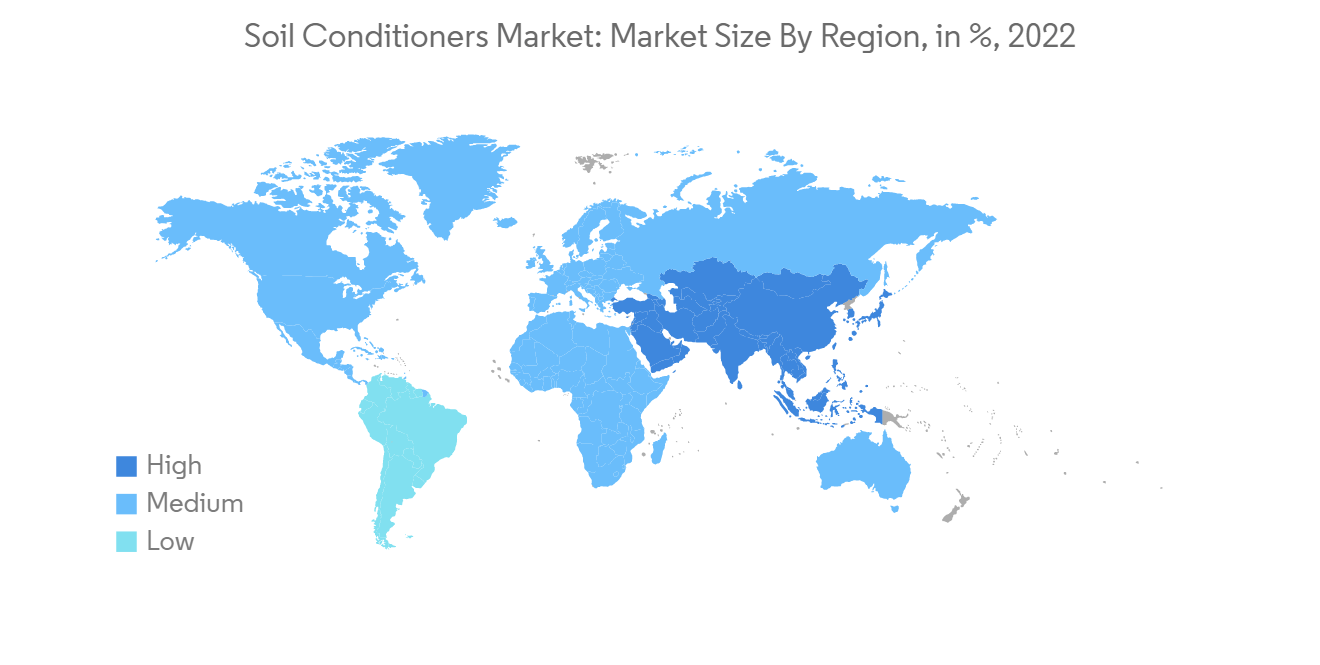
土壌改良剤の業界概要
市場は非常に細分化されており、多くの国内外のプレーヤーが市場で活動しています。UPL Limited、Saint-Gobain Group、Omnia Holdings Limited、Evonik Industries AG、Sanoway GmbHは、市場で事業を展開している著名なプレイヤーの一部です。これらの企業は、さまざまな地域の生産者のニーズに応える新製品を開発しています。これらの企業は、製品の品質や製品プロモーションで競争するだけでなく、より大きなシェアを獲得し、獲得した市場規模を拡大するために、買収や拡張などの他の戦略的な動きにも力を入れています。
その他の特典:
- エクセル形式の市場予測(ME)シート
- 3ヶ月間のアナリストサポート
目次
第1章 イントロダクション
- 調査の前提条件と市場定義
- 本調査の対象範囲
第2章 調査手法
第3章 エグゼクティブサマリー
第4章 市場力学
- 市場概要
- 市場促進要因
- 市場抑制要因
- ポーターのファイブフォース分析
- 買い手の交渉力
- 供給企業の交渉力
- 新規参入業者の脅威
- 代替品の脅威
- 競争企業間の敵対関係
第5章 市場セグメンテーション
- 製品タイプ
- オーガニック
- コンポスト
- 緑肥・家畜糞尿
- 泥炭
- その他有機系
- 無機系
- ポリマー
- 石膏
- オーガニック
- 地域
- 北米
- 米国
- カナダ
- メキシコ
- その他北米地域
- 欧州
- スペイン
- 英国
- フランス
- ドイツ
- イタリア
- ロシア
- その他欧州
- アジア太平洋地域
- 中国
- インド
- 日本
- オーストラリア
- その他アジア太平洋地域
- 南米
- ブラジル
- アルゼンチン
- その他南米地域
- アフリカ
- 南アフリカ
- アフリカの残りの地域
- 北米
第6章 競合情勢
- 最も採用されている戦略
- 市場シェア分析
- 企業プロファイル
- UPL Limited
- Southern Petrochemical Industries Corporation Ltd(SPIC)
- Saint-Gobain Group
- Omnia Holdings Limited
- Sanoway GmbH
- Evonik Industries AG
- Mangalore Chemicals & Fertilizers Limited
第7章 市場機会および将来動向
The global soil conditioners market is projected to register a CAGR of 5.8% during the forecast period.
Key Highlights
- Due to the intensive use of fertilizers, soil degradation has become a global problem, leading to the depletion of organic matter and soil fertility. Meanwhile, the intensification of agriculture accompanied by urbanization and industrialization has drastically accelerated the waste generation rate.
- For instance, coal mining produces wastes in large quantities globally, most of which end up in landfills or dump into storage dams. Accordingly, sustainable food production is driving global innovations to utilize various waste materials better to make value-added products, such as soil conditioners.
- Nowadays, soil conditioners are important in improving plant growth and soil health and reducing chemical fertilizer use. For instance, Phosphorus run-off from agriculture fields in southern Finland is the largest threat to water quality and living marine resources in this area of the Baltic Sea, and traditional farming methods have proven inadequate. So, using gypsum as a soil amendment on agricultural fields will reduce run-off pollution by 50%, decrease demand for virgin-mined phosphorus, and reuse industrial waste. This will encourage the growth of the market in the coming years.
- Soil management is an increasingly important global issue. According to Food and Agriculture Organization (FAO), 38% of global soil has been degraded, which causes the loss of soil organic matter, salinity, acidity, or alkalinity, and a decline in fertility. The degradation of soil conditions and structure, the need for food security, and enhanced nutrient management in the soil are some factors driving the market growth for soil conditioners in the coming years.
Soil Conditioners Market Trends
Degradation of Soil Condition and Soil Structure
- According to the Food and Agriculture Organization (FAO), the land equipped for irrigation is expected to expand by 32.0 million hectares, while harvested irrigated land is expected to expand by 17.0% by 2050. These scenarios are expected to be witnessed in developing countries, resulting in insufficient crop nutrient supply.
- According to a United Nations estimate, about 1.9 billion hectares of land have lost productivity, and 2 billion people are affected by land degradation globally. If land degradation continues at this pace, 95% of the Earth's land areas will be degraded by 2050. Thus, this leads to a lower yield of crops, along with a decline in the quality of the final product.
- The growing population worldwide is resulting in a decline in the proportion of arable land primarily used to produce food. This necessitates cultivation in poor soils. Soil degradation, directly and indirectly, affects agricultural productivity and water quality due to the increase in soil erosion, overgrazing, and other human-induced activities, such as deforestation, mining, industrial development, etc. Increasing soil conditioners and irrigation use efficiencies address the input side of the equation to the soil condition, which has been driving the market for soil conditioners in recent times.
- Farmers worldwide use soil conditioners, such as green manure, compost, etc., to recover soil fertility and address the soil structure so that it helps the plants take up nutrients and water efficiently. According to the Research Institute of Organic Agriculture (German: Forschungsinstitut fur biologischen Landbau) (FiBL), the global organic farmland had increased by 76.4 million hectares in 2021 compared to the previous year. Companies in the market are introducing new products to cater to the farmers' demands for improving soil conditions and structure.

Asia Pacific Dominates the Market
- Asia-Pacific is considered to be one of the largest markets for agricultural products due to its large fertile lands and favorable climatic conditions. Despite these favorable conditions, the region is witnessing severe soil degradation due to frequent cropping to meet the food demand. In such a scenario, soil conditioners, such as compost, play an important role as a replacement or supplement for chemical fertilizers in replenishing nutrient-depleted soil.
- In countries like India, organic manure, including farmyard manure and green manure, is the oldest and most widely practiced means of nutrient replenishment for plants. As per a report by the Food and Agriculture Organization (FAO), due to the high animal population in India, farmyard manure is the most common organic manure, with cattle accounting for 90% of the total manure production in the country.
- A rise in soil erosion rates, land clearance, deforestation, etc., have induced farmers to rely on soil conditioners to improve yields and soil health to address the growing food demand of the ever-increasing population in the region. Especially for markets like China, with excessive chemical fertilizers and pesticides applied to intensive cultivation, the soil has degraded mainly in the past decades. Now growers demand effective solutions to their specific soil problems. Major producers are investing in R&D to innovate new product lines to solve the problems related to the soil to make the region sustainable without causing any loss in the production of agricultural crops. Thus, this is expected to drive the market for soil conditioners in the future.

Soil Conditioners Industry Overview
The market is highly fragmented, with the presence of many local and international players operating in the market. UPL Limited, Saint-Gobain Group, Omnia Holdings Limited, Evonik Industries AG, and Sanoway GmbH are some of the prominent players who are operating in the market. These players are innovating new products that cater to the needs of growers across various regions. These companies are not only competing on the basis of product quality or product promotion but are also focused on other strategic moves, like acquisitions and expansions, to acquire a larger share and expand their acquired market size.
Additional Benefits:
- The market estimate (ME) sheet in Excel format
- 3 months of analyst support
TABLE OF CONTENTS
1 INTRODUCTION
- 1.1 Study Assumptions and Market Definition
- 1.2 Scope of the Study
2 RESEARCH METHODOLOGY
3 EXECUTIVE SUMMARY
4 MARKET DYNAMICS
- 4.1 Market Overview
- 4.2 Market Drivers
- 4.3 Market Restraints
- 4.4 Porter's Five Forces Analysis
- 4.4.1 Bargaining Power of Buyers
- 4.4.2 Bargaining Power of Suppliers
- 4.4.3 Threat of New Entrants
- 4.4.4 Threat of Substitute Products
- 4.4.5 Intensity of Competitive Rivalry
5 MARKET SEGMENTATION
- 5.1 Product Type
- 5.1.1 Organic
- 5.1.1.1 Compost
- 5.1.1.2 Green and Farmyard Manure
- 5.1.1.3 Peat
- 5.1.1.4 Other Organic Types
- 5.1.2 Inorganic
- 5.1.2.1 Polymers
- 5.1.2.2 Gypsum
- 5.1.1 Organic
- 5.2 Geography
- 5.2.1 North America
- 5.2.1.1 United States
- 5.2.1.2 Canada
- 5.2.1.3 Mexico
- 5.2.1.4 Rest of North America
- 5.2.2 Europe
- 5.2.2.1 Spain
- 5.2.2.2 United Kingdom
- 5.2.2.3 France
- 5.2.2.4 Germany
- 5.2.2.5 Italy
- 5.2.2.6 Russia
- 5.2.2.7 Rest of Europe
- 5.2.3 Asia Pacific
- 5.2.3.1 China
- 5.2.3.2 India
- 5.2.3.3 Japan
- 5.2.3.4 Australia
- 5.2.3.5 Rest of Asia Pacific
- 5.2.4 South America
- 5.2.4.1 Brazil
- 5.2.4.2 Argentina
- 5.2.4.3 Rest of South America
- 5.2.5 Africa
- 5.2.5.1 South Africa
- 5.2.5.2 Rest of Africa
- 5.2.1 North America
6 COMPETITIVE LANDSCAPE
- 6.1 Most Adopted Strategies
- 6.2 Market Share Analysis
- 6.3 Company Profiles
- 6.3.1 UPL Limited
- 6.3.2 Southern Petrochemical Industries Corporation Ltd (SPIC)
- 6.3.3 Saint-Gobain Group
- 6.3.4 Omnia Holdings Limited
- 6.3.5 Sanoway GmbH
- 6.3.6 Evonik Industries AG
- 6.3.7 Mangalore Chemicals & Fertilizers Limited
